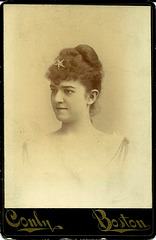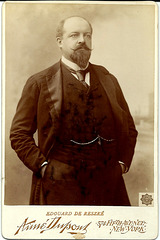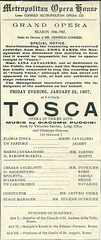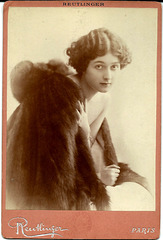OperaMania's photos
Victor Maurel by Aime Dupont
| |
|
|
as Don Giovanni in "Don Giovanni' by Mozart
VICTOR MAUREL
June 17, 1848 – October 22, 1923).
Baritone
Debuted at the Opera March 04, 1868. Debuted at the Opéra-Comique on 06 October 1885 in Etoile du Nord (Peters)Chante Zampa, le Songe d'une nuit d'été, Don Juan.. Sang Falstaff (Falstaff) from 1900, le Juif Polonais (Mathis), He created two roles. Verdi had chosen him to create Otello (Iago) and Falstaff (Falstaff) at the Scala in Milan. In 1883, he attempted to resurrect the Théâtre Italien in Paris.
Clara Louise Kellogg by Sarony
| |
|
CLARA LOUISE KELLOGG
(July 9, 1842 – May 13, 1916) was an American soprano She completed her studies in New York and was there in 1861 at the Academy of Music with her debut as Gilda in "Rigoletto" already their first success. She sang at the same opera house on 11/26/1863 then the Marguerite in the New York premiere of Gounod's "Faust". In 1863 she appeared as a guest on Her Majesty's Theatre in London. She attracted here as Traviata, Linda di Chamounix as in the opera of the same name by Donizetti, as Zerlina in "Don Giovanni" and Martha as large in the famous opera by Flotow sensation. The composer Luigi Arditi wrote for them the "Kellogg-Waltz", a coloratura bravura aria she lectured in the finale of the opera "Linda di Chamounix" as a deposit. 1868-72 she undertook extensive tours in the United States. 1872 was then played again in London as a guest. 1872 she founded along with great Prima Donna Pauline Lucca Lucca the Kellogg Opera Company, but only temporarily had stock. 1873-76 she was Director of the English Opera Company, with which she took great guest tours through the North American continent. These troops deployed such activity, that they hosted 125 performances during a Stagione, in which Clara Louis Kellogg occurred again and again as a singer. 1877 she joined the opera troupe Tre Grazie, which the impresario Carl Rosa undertook a tour through the United States. 1879, she appeared again at the Her Majesty's Theatre in London, now admired above all as Aida and as Philina in the opera "Mignon" of A.Thomas. In 1880 she appeared in Vienna in 1881 at the Court Opera of St. Petersburg. In 1887 she took the stage farewell, when she married her manager Carl Strakosch
Riccardo Martin by Aime Dupont
| |
|
as Enzo in "La Gioconda" by Ponchielli:
Riccardo Martin
(Hugh Whitfield Martin)
(November 18, 1874 – August 11, 1952)
American tenor.
Studied in Paris with Giovanni Sbriglia, Jean de Reszke and Léon Escalaïs. and later completed his studies with Vincenzo Lombardi in Florence and Beniamino Carelli in Naples. He debuted as Faust in Nantes in 1904. Two years later he made his American debut in New Orleans, singing with the visiting San Carlo Opera. Debut at the Metropolitan Opera on November 20, 1907 in Mefistofele; he created the lead tenor roles in 3 american operas: Walter Damrosch's " Cyrano", Horatio Parker's "Mona", and Frederick Shepherd Converse's" The Pipe of Desire". After leaving the company he appeared with numerous companies throughout America and Europe, and spent three seasons with the Chicago Civic Opera.
Marcel Journet by Aime Dupont
| |
|
as Escamillo in "Carmen" by Bizet
Marcel Journet
July 25, 1868 – September 7, 1933)
French, bass,
Studied at the Paris Conservatory. He made his operatic debut at Montpellier in 1891.He sang at The Royal Opera House at London's Covent Garden, Milan's La Scala, the Paris Opera and the New York Metropolitan Opera, Sang a wide range of roles in operas by Richard Wagner and major French and Italian composers during a distinguished, 40-year career.
Jean Lassalle by Falk
| |
|
JEAN-LOUIS LASALLE -Baritone (.Lyon, December 10, 1845 or 14 February 1847 - September 07, 1909). Father of Robert Lassalle tenor. Student at Paris Concervatoire and later a pupil of Novelli.He made his first appearance on stage as St Bris in "Les Huguenot's" at Liege in 1868. During the next 4 years he sang at Lille , Toulouse , Brussels and the Hague . Debuted at the Opera on 09 June 1872 , as Nelusko "L'Africane". There he took part in many world premieres as Scindia in Massenet's "La Roi De Lahore" 1877 , Severe in Gounod's "Polyeucte" 1878 ,Ben Said in Gounod's "Le Tribute de Zamora ' 1880 ,Malatesta in Thomas's 'Francoise de Rimini" 1880 , and in 1183 the title role of Saint Saens "Henry VIII". He sang at Covent Garden 1879 , 1880 and 1881 and again between 1883-1891.In 1891 he made his Metropolitan Debut as Nelusko in Meyerbeer's "L'Africane". He sang Carmen (Escamillo) at the Opéra-Comique on December 11, 1890, for the erection of the monument to the memory of Bizet.
Johanna Gadski by Aime Dupont
| |
|
in unknown role
JOHANNA GADSKI
(15 June 1872 – 22 February 1932)
German Soprano
Studied in Stettin. Debut Berlin as Undine "Undine" Tchaikovsky .appearanced in the works of Wagner's at the 1899 Bayreuth Festival and at the 1905/06 Munich Festival.
American debut in New York in 1895 with the Damrosch Opera Company .In 1896 she created the role of Hester Prynne in the fully staged premiere of Walter Damrosch's opera The Scarlet Letter in Boston. Sang in London at the Royal Opera House, Covent Garden, in 1899, 1900, 1901 and 1906.She had also joined the star-studded roster of singers at the New York Metropolitan Opera, singing there from 1898 to 1904 and again from 1907 to 1917.At the height of World War I, however, she was obliged to resign from the Metropolitan Opera because of her German links. Gadski resumed her professional concert career in the United States in 1921. She did not return to the operatic stage, however, until the late 1920s; her first such appearance being in a 1928 production of Die Walküre mounted by the Washington National Opera, a semi-professional company not Thereafter, in the years 1929 to 1931, she toured as the star of the German Grand Opera Company
Marie Heilbronn by Benque
| |
|
Marie Heilbronn as Manon 'Manon" Massenet CREATOR
MARIE HEILBRONN
( 1851- 31 March 1886).
Belgian soprano.
She studied in Paris and made her début in 1867 at the Opéra-Comique, as Alice in the first performance of Jules Massenet's "La grand’tante". In 1870 she appeared at La Monnaie as Violetta, the role of her début at Covent Garden in 1874, and in 1878 at the Théâtre Ventadour as Juliet in Victor Capoul's "Les amants". She returned in 1879 as Ophelia (Hamlet). The same year she appeared at the Paris Opéra as Marguerite and in 1880 she sang Zerlina and Ophelia there. At Monte Carlo in 1883 she sang Susanna, Philine (Mignon), Marguerite, Victor Massé's Galatea and Rose in Aimé Maillart's Dragons de Villars. In 1884 she created the title role of Massenet's "Manon" at the Opéra-Comique.
Emma Eames by Falk
| |
|
as Amelia in "Un Ballo un Maschera" by Verdi
EMMA EAMES
(August 13, 1865 - June 13, 1952)
American Soprano
Eames was born in Shanghai, China and raised in Portland and Bath in the American state of Maine.She attended school in Boston where she studied singing with Charles R. Adams.Later she took voice lessons in Paris with the highly successful but autocratic teacher of bel canto sopranos, Mathilde Marchesi.
Eames made her professional operatic debut in Gounod's Roméo et Juliette at the Paris Opéra's headquarters, the Palais Garnier, in 1889. She would perform the role of Juliette many other times during the next two years, while adding other leading French-opera parts to her repertoire. As early as November 1889, The Times newspaper called her "the favourite cantatrice of the Opera". She left the company in 1891, however, for personal reasons. Towards the end of 1891, Eames debuted at the Metropolitan Opera in New York City in her trademark part of Juliette, and she quickly became a favourite with Met audiences. She would perform regularly at the Met in a variety of operas until 1909, when a dispute with management precipitated her departure. Eames also made a number of successful appearances at London's Royal Opera House, Covent Garden. She sang there intermittently from 1891 to 1901 and established herself as a genuine rival to Covent Garden's reigning diva, Nellie Melba, whom she heartily disliked. Eames also sang in Madrid and fulfilled lucrative singing engagements at Monaco's chic Monte Carlo Opera during the 1890s.
In 1906, Eames visited San Francisco with a touring troupe of leading Met singers. She was fortunate to survive unscathed when a devastating earthquake and fire struck the city, damaging her hotel. Eames gave her farewell operatic performances during the 1911-12 seasons with the Boston opera company. She then undertook a series of concert tours of the United States
Jean De Reszke by Issoire
| |
|
JEAN DE RESZKE
(Jan Mieczyslaw RESZKE )
(14 January 1850 – 3 April 1925),
Polish Tenor
abandoned his legal training and went to Milan in Italy to study voice. The most acclaimed of the pedagogues consulted by the young de Reszke was Antonio Cotogni, an eminent baritone who was a favorite of Giuseppe Verdi's.
In January 1874, he made his debut in Venice as Jan de Reschi (he later changed it to Jean de Reszke), undertaking the baritone part of Alfonso in a production of Donizetti's La favorite . The following April, he sang for the first time in London, performing at the Theatre Royal, Drury Lane, and a little later in Paris, essaying an array of different baritone roles.
De Reszke displayed limitations as a baritone and he withdrew from the stage to allow for a further period of study, this time with Giovanni Sbriglia in Paris. Under Sbirgilia's tutelage, his voice gained remarkably in the freedom of its upper register. Accordingly, when he made his first operatic reappearance in 1879 (in Madrid), it was as a tenor, scoring a success in the title-role of Meyerbeer's Robert le diable. Indeed, the then 29-year-old de Reszke's immense fame as a singer dates
Jean De Reszke by Aime Dupont
| |
|
as Tristan in "Tristan & Isolde" by Wagner
JEAN DE RESZKE
(Jan Mieczyslaw RESZKE )
(14 January 1850 – 3 April 1925),
Polish Tenor
abandoned his legal training and went to Milan in Italy to study voice. The most acclaimed of the pedagogues consulted by the young de Reszke was Antonio Cotogni, an eminent baritone who was a favorite of Giuseppe Verdi's.
In January 1874, he made his debut in Venice as Jan de Reschi (he later changed it to Jean de Reszke), undertaking the baritone part of Alfonso in a production of Donizetti's La favorite . The following April, he sang for the first time in London, performing at the Theatre Royal, Drury Lane, and a little later in Paris, essaying an array of different baritone roles.
De Reszke displayed limitations as a baritone and he withdrew from the stage to allow for a further period of study, this time with Giovanni Sbriglia in Paris. Under Sbirgilia's tutelage, his voice gained remarkably in the freedom of its upper register. Accordingly, when he made his first operatic reappearance in 1879 (in Madrid), it was as a tenor, scoring a success in the title-role of Meyerbeer's Robert le diable. Indeed, the then 29-year-old de Reszke's immense fame as a singer dates
Jean De Reszke by Mieczkowski
| |
|
as Romeo in "Romeo & Juliette" by Gounod
JEAN DE RESZKE
(Jan Mieczyslaw RESZKE )
(14 January 1850 – 3 April 1925),
Polish Tenor
abandoned his legal training and went to Milan in Italy to study voice. The most acclaimed of the pedagogues consulted by the young de Reszke was Antonio Cotogni, an eminent baritone who was a favorite of Giuseppe Verdi's.
In January 1874, he made his debut in Venice as Jan de Reschi (he later changed it to Jean de Reszke), undertaking the baritone part of Alfonso in a production of Donizetti's La favorite . The following April, he sang for the first time in London, performing at the Theatre Royal, Drury Lane, and a little later in Paris, essaying an array of different baritone roles.
De Reszke displayed limitations as a baritone and he withdrew from the stage to allow for a further period of study, this time with Giovanni Sbriglia in Paris. Under Sbirgilia's tutelage, his voice gained remarkably in the freedom of its upper register. Accordingly, when he made his first operatic reappearance in 1879 (in Madrid), it was as a tenor, scoring a success in the title-role of Meyerbeer's Robert le diable. Indeed, the then 29-year-old de Reszke's immense fame as a singer dates
Jean De Reszke by Aime Dupont
| |
|
as Raoul in "Les Huguenots' By Meyerbeer
JEAN DE RESZKE
(Jan Mieczyslaw RESZKE )
(14 January 1850 – 3 April 1925),
Polish Tenor
abandoned his legal training and went to Milan in Italy to study voice. The most acclaimed of the pedagogues consulted by the young de Reszke was Antonio Cotogni, an eminent baritone who was a favorite of Giuseppe Verdi's.
In January 1874, he made his debut in Venice as Jan de Reschi (he later changed it to Jean de Reszke), undertaking the baritone part of Alfonso in a production of Donizetti's La favorite . The following April, he sang for the first time in London, performing at the Theatre Royal, Drury Lane, and a little later in Paris, essaying an array of different baritone roles.
De Reszke displayed limitations as a baritone and he withdrew from the stage to allow for a further period of study, this time with Giovanni Sbriglia in Paris. Under Sbirgilia's tutelage, his voice gained remarkably in the freedom of its upper register. Accordingly, when he made his first operatic reappearance in 1879 (in Madrid), it was as a tenor, scoring a success in the title-role of Meyerbeer's Robert le diable. Indeed, the then 29-year-old de Reszke's immense fame as a singer dates
Edouard De Reszke & Jean De Reszke by Benque
| |
|
De Reszke brothers as Don Diegue & Rodrigue "Le Cid" by Massenet CREATOR'S Paris 30/11/1885
JEAN DE RESZKE
(Jan Mieczyslaw RESZKE )
(14 January 1850 – 3 April 1925),
Polish Tenor
abandoned his legal training and went to Milan in Italy to study voice. The most acclaimed of the pedagogues consulted by the young de Reszke was Antonio Cotogni, an eminent baritone who was a favorite of Giuseppe Verdi's.
In January 1874, he made his debut in Venice as Jan de Reschi (he later changed it to Jean de Reszke), undertaking the baritone part of Alfonso in a production of Donizetti's La favorite . The following April, he sang for the first time in London, performing at the Theatre Royal, Drury Lane, and a little later in Paris, essaying an array of different baritone roles.
De Reszke displayed limitations as a baritone and he withdrew from the stage to allow for a further period of study, this time with Giovanni Sbriglia in Paris. Under Sbirgilia's tutelage, his voice gained remarkably in the freedom of its upper register. Accordingly, when he made his first operatic reappearance in 1879 (in Madrid), it was as a tenor, scoring a success in the title-role of Meyerbeer's Robert le diable. Indeed, the then 29-year-old de Reszke's immense fame as a singer dates
EDOUARD DE RESZKE,
(22 December 1853 – 25 May 1917)
Polish bass
His voice studies in Italy with Giovanni Sbriglia, He was chosen by the composer Giuseppe Verdi to make his debut in the first Paris performance of Aida on 22 April 1876, appearing under the composer's baton as the King of Egypt.
Between the start of 1880 and the end of 1900, Édouard de Reszke appeared on more than 300 occasions at the Royal Opera House, Covent Garden, performing a wide range of roles in French, German and Italian operas, including works by Wagner, Verdi, Rossini, Bellini, Donizetti, Ponchielli, Gounod, Meyerbeer, Flotow and Mozart.
At New York's Metropolitan Opera during the same era. He also sang in Chicago in 1891 and, in 1879–1881, at La Scala, Milan. In 1903, he retired from the stage after his once superlative voice developed technical difficulties and went into a swift decline.
De Reszke taught singing for a while in London before returning to his estate in Poland,
Le Cid . Metropolitan Opera .8th February 1901
Zelie De Lussan by C F Conley
| |
|
ZELIE DE LUSSAN
(21 December 1861 – 18 December 1949)
American Soprano
Zélie de Lussan was born in Brooklyn, New York, to French parents , her mother was a soprano ,training with her mother, de Lussan made her operatic début in 1884 in Boston, Massachusetts, as Arline in Balfe's The Bohemian Girl.Augustus Harris engaged her to appear in the first season under his management at Covent Garden, London, and as Carmen she made the part "peculiarly her own."
In London her successes included Zerlina in Don Giovanni, and, in 1897, Musetta in London's first performances of La bohème. Her singing greatly impressed Queen Victoria, and she was more than once invited to sing at BaImoral and Windsor Castle In 1894 she made her début at the Metropolitan Opera as Carmen, and appeared there for three seasons in roles including Nannetta (Falstaff), Zerlina, and Nedda (Pagliacci). In 1910 she sang Cherubino in The Marriage of Figaro in Thomas Beecham's Mozart season at His Majesty's Theatre .After her marriage in 1907 to the pianist Angelo Fronani she gradually retired, though she played Carmen as late as 1915
Edouard De Reszke by Aime Dupont
| |
|
EDOUARD DE RESZKE,
(22 December 1853 – 25 May 1917)
Polish bass
His voice studies in Italy with Giovanni Sbriglia, He was chosen by the composer Giuseppe Verdi to make his debut in the first Paris performance of Aida on 22 April 1876, appearing under the composer's baton as the King of Egypt.
Between the start of 1880 and the end of 1900, Édouard de Reszke appeared on more than 300 occasions at the Royal Opera House, Covent Garden, performing a wide range of roles in French, German and Italian operas, including works by Wagner, Verdi, Rossini, Bellini, Donizetti, Ponchielli, Gounod, Meyerbeer, Flotow and Mozart.
At New York's Metropolitan Opera during the same era. He also sang in Chicago in 1891 and, in 1879–1881, at La Scala, Milan. In 1903, he retired from the stage after his once superlative voice developed technical difficulties and went into a swift decline.
De Reszke taught singing for a while in London before returning to his estate in Poland,
Tosca, 25 January 1907 , Metropolitan Opera
Lina Cavalieri by Reutlinger
| |
|
Lina Cavalieri
25 December 1874 – 7 February 1944
Italian soprano
Worked as a café singer before taking voice lessons in Paris.Debut as Nedda in “Pagliacci” by Leoncavallo in Lisbon in 1900,She was singing at the Monte Carlo Opera in 1904 and at the Sarah Bernhardt theatre in Paris in 1905 & sang Fedora with Caruso in “Fedora” by Giordano,Made her American debut at the Metropolitan Opera New York in 1906 and remained for two seasons , From 1909-10 she was at the Manhattan Opera after which she returned to Europe in 1912.She created L’Ensoleilland in Cherubin” by Massenet in 1905 .She also sang in Russia and the Ukraine . Her third husband was the tenor Lucien Muratore.Her roles included Manon “Manon Lescaut” , Tosca “Tosca” , Mimi ‘La Boheme” l by Puccini, Thais “Thais”, Salome “Herodide” by Massenet , Violetta ‘La Traviata” , Gilda ‘Rigoletto” by Verdi and both Elena and Margarita ‘Mefistofele” by Boito


















